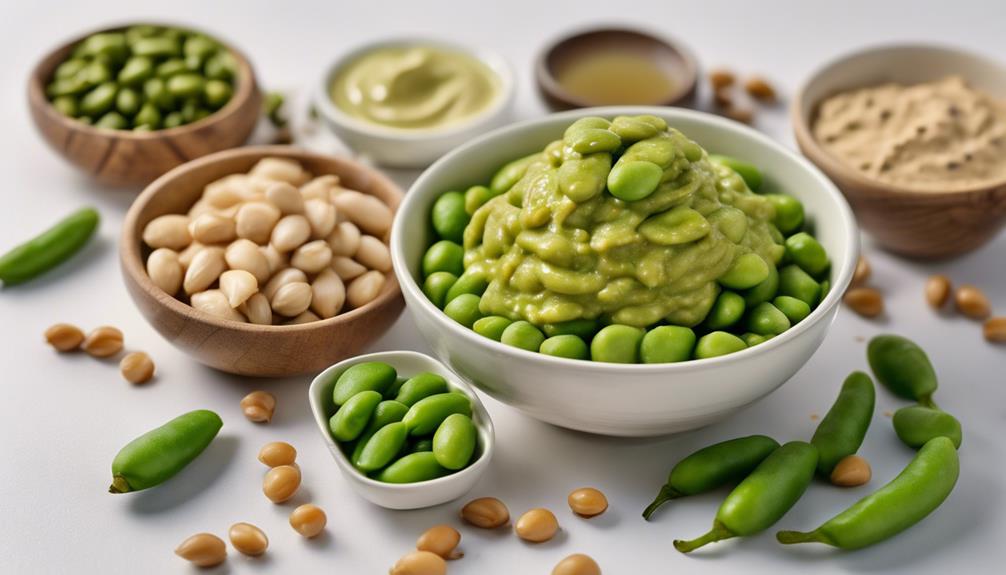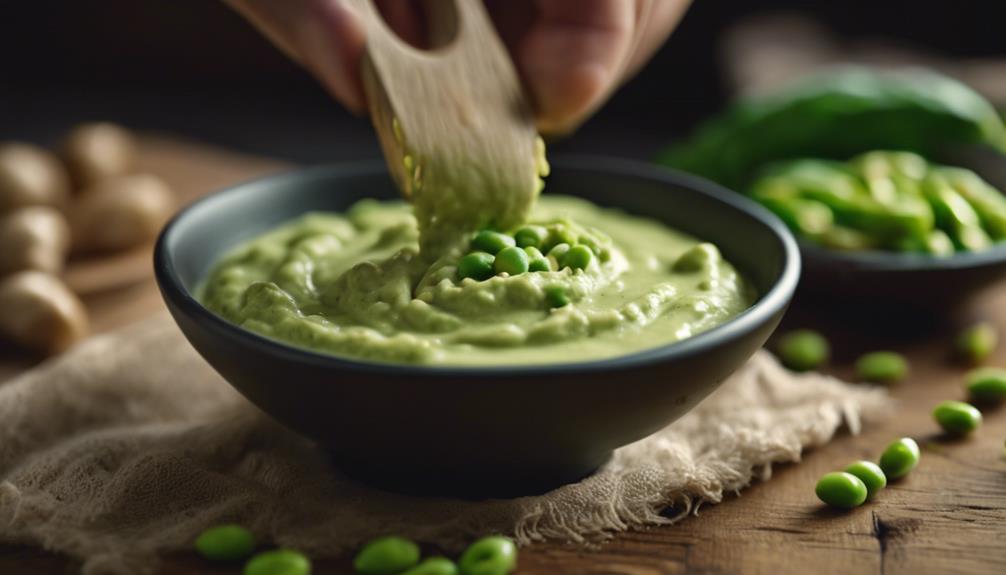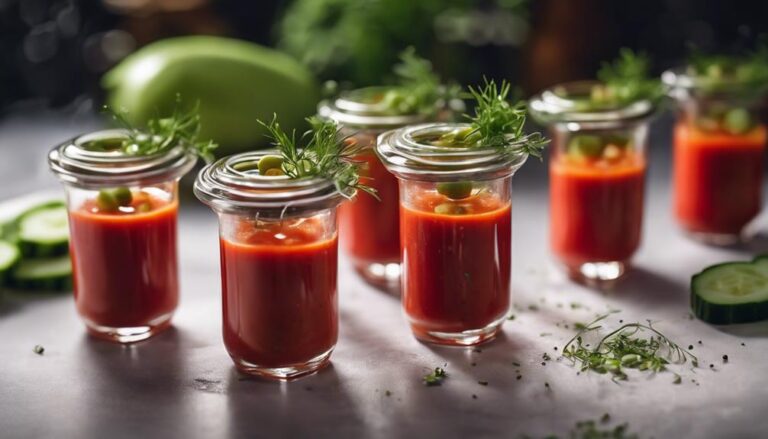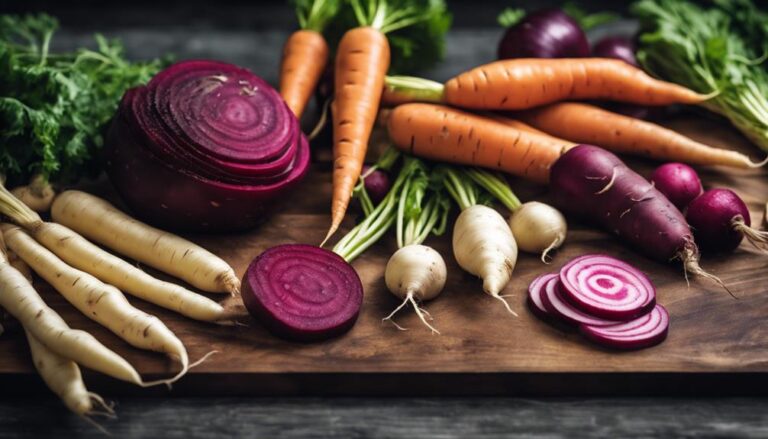Sous Vide Edamame Hummus
To achieve creamy Sous Vide Edamame Hummus, cook beans precisely for even texture. Control temperature to maintain flavors and nutrients. Use olive oil for richness. Sous vide method prevents overcooking, leading to smooth consistency. Blend with water for creaminess. Scrape down blender for well-mixed dip. Store airtight for freshness. Enhance taste with quality tahini and fresh lemon juice. Balance creaminess and acidity. Prep ahead for quick, healthy snacks. Variations offer lighter, citrusy options. Try sous vide for perfect hummus every time.
What You Will Learn Here
- Sous vide cooking ensures precise and even edamame bean cooking.
- Maintains creamy texture and delicate flavors through controlled temperature.
- Retains nutrients of edamame and enhances creaminess with olive oil.
- Consistent hummus texture achieved by scraping down blender sides.
- Store in airtight container with high-quality tahini for freshness and taste.
Origin of Edamame Hummus

Edamame hummus is a novel adaptation of traditional hummus, featuring edamame beans as the primary ingredient. Its unique blend of tahini, lemon juice, garlic, cilantro, and edamame creates a distinctive flavor profile.
Understanding the origin of edamame hummus involves exploring its ingredients, preparation methods, and nutritional benefits.
Edamame Hummus Ingredients
The evolution of hummus recipes has seen a remarkable adaptation with the introduction of edamame beans as a key ingredient, offering a distinctive flavor and texture compared to traditional chickpea-based hummus.
To prepare edamame hummus, you'll need shelled edamame, tahini, lemon juice, garlic, and cilantro. These ingredients combined in a food processor create a creamy and flavorful dip with a fresh and zesty taste profile.
Edamame hummus isn't only a versatile dip suitable for serving with pita, crackers, or fresh vegetable sticks but also adds visual appeal to any dish with its vibrant green color.
Additionally, this hummus variation provides a nutritious alternative rich in plant-based protein and essential nutrients, making it a healthy and delicious choice for various occasions.
Making Edamame Hummus
Originating from the fusion of traditional Middle Eastern hummus with East Asian influences, the creation of edamame hummus introduces a unique twist to the classic dip. Edamame hummus is made by blending cooked edamame beans with tahini, lemon juice, garlic, and cilantro leaves.
The edamame beans provide a smooth texture and a slightly nutty flavor, differentiating it from chickpea-based hummus. Tahini adds a creamy consistency and richness to the dip, while lemon juice offers a tangy kick. The addition of garlic enhances the overall savory profile, and cilantro leaves contribute a fresh herbal note.
This combination results in a vibrant green hummus that isn't only visually appealing but also a nutritious protein-packed alternative to traditional hummus.
Nutritional Value of Edamame
Harvested at an early stage, edamame provides a rich source of protein, fiber, and essential nutrients, making it a valuable ingredient for creating nutritious dishes like edamame hummus.
Edamame is a complete protein, containing all essential amino acids important for human health. Additionally, it's low in calories and carbohydrates, suitable for a balanced diet.
Rich in plant-based iron, edamame supports healthy blood circulation and oxygen transport in the body. Furthermore, edamame is abundant in antioxidants such as vitamin C and vitamin E, aiding in combating oxidative stress and inflammation.
Including edamame in your diet not only boosts protein intake but also provides essential nutrients and antioxidants essential for overall well-being.
Edamame Hummus Ingredient Variations

For enhanced flavor profiles in your edamame hummus, contemplate experimenting with ingredient variations such as substituting cilantro for parsley or Thai basil. These variations can cater to different taste preferences and add a unique twist to your traditional edamame hummus recipe. When adjusting your ingredients, keep in mind the importance of maintaining a balance between flavors to achieve a harmonious blend in your hummus.
Here are three ingredient alternatives to contemplate:
- Herb Substitutions: Swap out traditional parsley for cilantro or Thai basil to introduce a fresh and aromatic element to your edamame hummus.
- Spice Infusions: Incorporate spices like cumin or smoked paprika to add depth and complexity to the flavor profile of your hummus.
- Nutty Notes: Experiment with different types of nuts or seeds, such as toasted pine nuts or sesame seeds, to enhance the nuttiness of your edamame hummus.
Chickpea Edamame Hummus Variations
Chickpea edamame hummus variations like Edamame Hummus With Roasted Garlic, Edamame Hummus With Lemon, and Lemon-Ginger Edamame Hummus Recipe offer diverse flavors and aromatic profiles. These variations showcase the adaptability of combining chickpeas and edamame, providing a range of taste experiences.
Experimenting with different seasoning and ingredient combinations can elevate the nutritional profile and overall appeal of chickpea edamame hummus.
Edamame Hummus With Roasted Garlic
Incorporating edamame into traditional hummus results in a unique taste and texture profile, enhanced by the addition of roasted garlic for rich, caramelized flavor. This variation of hummus offers a delightful twist on the classic recipe, providing a creamy and savory dip or spread that's both delicious and packed with nutrients. The roasted garlic infuses a subtle sweetness and depth of flavor, making it a versatile and crowd-pleasing dish.
Here are three key points about Edamame Hummus With Roasted Garlic:
- Edamame hummus with roasted garlic offers a protein-packed snack or appetizer option.
- The combination of edamame and roasted garlic creates a rich and complex flavor profile.
- Roasted garlic enhances the depth and creaminess of the hummus, making it a satisfying and healthy choice.
Edamame Hummus With Lemon
The addition of lemon in edamame hummus enhances its flavor profile with a vibrant and citrusy twist, amplifying the nuttiness of the edamame beans. When combined with sous vide cooking, this variation offers a unique and gluten-free spin to traditional hummus recipes.
- Nutrient-Dense: Edamame hummus with lemon provides a boost of plant-based protein, fiber, and essential nutrients, promoting a healthy snacking option.
- Lively Flavor: The zesty lemon complements the earthy edamame beans, creating an invigorating and tangy taste experience that appeals to a wide range of palates.
- Smooth Consistency: The creamy texture of this hummus variation makes it ideal for dipping with gluten-free options like pita bread, crackers, or fresh vegetable sticks.
Lemon-Ginger Edamame Hummus Recipe
Enhance the flavor profile of your edamame hummus with a lively twist by incorporating fresh lemon and warm ginger in this versatile recipe.
The fusion of lemon and ginger adds depth to the edamame hummus, creating a distinctive and invigorating flavor profile. Ginger's subtle heat and earthy notes complement the citrusy essence from the lemon, amplifying the overall taste experience.
This Lemon-Ginger Edamame Hummus recipe offers customization options, allowing you to adjust the levels of ginger and lemon to suit your taste preferences precisely.
Sous Vide Hummus Texture
Sous vide cooking plays an essential role in achieving a consistently smooth and creamy texture in edamame hummus.
The controlled temperature guarantees even cooking of the edamame, resulting in an ideal texture that's both velvety and professional.
This precision prevents overcooking, preserving the hummus's integrity and leading to a delightful, creamy outcome.
Smooth Hummus Texture
Achieve a consistently smooth texture for your edamame hummus through the precise control of sous vide cooking methods. Sous vide cooking guarantees that the edamame is evenly cooked, resulting in a velvety hummus texture.
The precise temperature control in sous vide prevents overcooking, maintaining the creaminess of the hummus. Compared to traditional cooking methods, sous vide retains more nutrients in the edamame, enhancing the hummus's overall nutritional value.
Traditional methods often lead to unevenly cooked edamame, impacting the final texture of the hummus. By utilizing sous vide, you secure a foolproof way to achieve a consistently smooth and professional finish for your hummus, ensuring a delightful experience for those you serve.
Creamy Sous Vide
For a velvety smooth texture in your edamame hummus, precise sous vide cooking evenly cooks the beans, ensuring an essential finish.
The creamy texture of the hummus is achieved through the controlled temperature of the sous vide method, allowing the edamame beans to cook gently and uniformly. This temperature control is vital in retaining the delicate flavors and nutrients of the edamame, resulting in a rich and satisfying hummus.
Additionally, the use of olive oil in the sous vide process enhances the creaminess of the hummus, creating a luscious texture that's consistent and top-quality.
Consistent Hummus Texture
To maintain a consistently smooth texture in your hummus, the sous vide method plays a crucial role in maintaining precise temperature control during the cooking process. Sous vide cooking guarantees that the beans are evenly cooked, preventing overcooking and resulting in a creamy texture.
When blending the cooked beans, adding a couple of tablespoons of water can help achieve a smoother consistency. It's essential to scrape down the sides of the blender to ensure all ingredients are well incorporated, contributing to a professional finish.
The uniform cooking of beans through sous vide technology leads to a high-quality hummus with a desirable texture. This method not only enhances the overall nutritional value of the hummus but also ensures a consistently delicious outcome.
Final Thoughts
In conclusion, the sous vide edamame hummus offers a delightful alternative to traditional chickpea-based dips, showcasing a harmonious blend of flavors and textures.
When storing this vibrant green hummus, transfer it to an airtight container to maintain its freshness and prevent any absorption of unwanted odors from the refrigerator. Remember to use high-quality tahini and fresh lemon juice to enhance the overall taste profile of the hummus. These ingredients play an essential role in balancing the creaminess and acidity of the dip, ensuring a satisfying culinary experience for you and your guests.
By making this edamame hummus ahead of time, you can conveniently serve it as a healthy appetizer or snack throughout the week, saving you time and effort in the kitchen. The versatility of this recipe makes it a crowd-pleaser, appealing to those seeking a lighter, more citrusy option compared to traditional hummus varieties.
Enjoy the invigorating twist that edamame hummus brings to your table.
Frequently Asked Questions
What Is Edamame Hummus Made Of?
Edamame hummus is crafted from edamame beans, tahini, and garlic. This blend offers a rich, creamy dip brimming with protein and flavor. It stands as a chickpea-free alternative, delivering a unique taste sensation.
How Many Carbs Are in Edamame Hummus?
Edamame hummus offers a moderate carb content, typically containing 5-7 grams per serving. Its nutritional value stems from edamame beans, tahini, and olive oil. This dip is a great choice for those with dietary restrictions.
Conclusion
To sum up, sous vide edamame hummus offers a unique twist on traditional hummus recipes.
The precise temperature control of the sous vide method allows for a smooth and creamy texture, enhancing the overall flavor profile of the dish.
By incorporating edamame, a protein-packed legume, this variation of hummus provides a nutritious and delicious option for those looking to explore new culinary creations.
Consider trying out this innovative recipe to elevate your next snacking experience.











